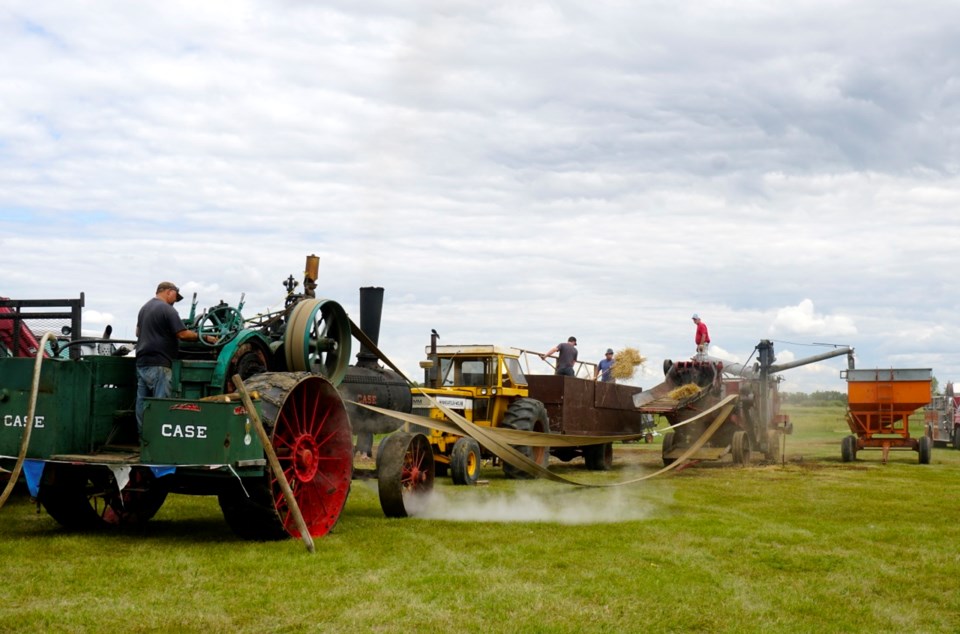I have to admit, in my 10 years in Canada between Manitoba and Saskatchewan, I'd never made it to a live threshing demonstration until last Sunday.
I've been to the Western Development Museums in Saskatoon and Moose Jaw, I've seen many old tractors and other old equipment, some in and around museums, others sitting on the sides of the roads, but I'd never really understood how it worked.
So ,my first visit to the Frobisher Threshermen's Day was definitely a great experience. Not only was it a nice community event with its parade and flying candies, bouncy castles and food trucks, but it also allowed me to have a touch of history, which got me thinking. First and foremost, the big, noisy machines in action definitely made me appreciate the comfort and efficiency of today's farming that much more.
The threshing demonstration, which at the event involved about 10 people and in reality, required at least 15, gripped my attention. Such a complicated and taking so many hands process was nevertheless smart, and when invented, made a big difference for farmers back in the day. The following baling process seemed almost more complex. The machine itself looked simpler, but it also required a number of men to operate it and a lot of hand labour.
(A side note, in my farming side of life, I sometimes get to roll rocks during seeding. For that, I use built-in-2000s front-wheel assist with autosteer, air conditioning, music, a comfy bouncing chair, cupholders, and, well, many of you know the setup of contemporary tractors. At some point, we didn't have enough people to pick rocks ahead of time, and when I was rolling, I had to get out of the tractor to push boulders into the bucket.
"That's not the way to do it," I'd whine, thinking it was too tough of a job. The threshing demo will probably keep me from complaining for a while now).
Even with all the equipment, 100 years ago, combining was way more complicated, time and labour consuming than today. But looking at those machines, even I could see a great engineer thought of potential for further improvements, which wasted little time.
Interestingly, most tractors participating in the parade, were comparable to contemporary ones, and the biggest change was the size. Of course, the steam engine one stood out, but machines like the 1920s tractor used for the threshing demo didn't last too long before they were replaced with more convenient ones. Other old agri equipment was hard to guess at first sight for such a layman as me. But once in action, I could see the mechanical part was already there, it's the arrangement and the electronic components that came in later and made the big difference in efficiency.
What stunned me even more was the realization of how far we've progressed in just 100 years.
(Another side note, throughout my years here, I noticed that the perception of time and historic periods differs for those coming from countries with longer history. People tend to think of things in relation to other experiences. In my mind, historically 100 years is a short time. I used to say that my city, which is just over 300 years old, is very young, which it was compared to other places in the region. But a lot of people I met here would say that 100 years is a very long time ago, as things have drastically changed).
Standing there in front of the machine that required 15-plus strong people to operate it, I couldn't stop thinking about the combines going down the fields, run by one person and able to cover up to about 5,000 acres a season. The picture has completely changed in just three or four generations, with progress not only transforming the job but also reshaping the industry.
The number of farm operations in Saskatchewan fell from close to 140,000 in the 1940s to just about 40,000 in the mid-2010s and kept declining, while the total area of cropland increased.
That old equipment also reminded me how complicated it was for ancestors and remains for today's farmers, who often need to come up with engineered solutions and know-how right at the field or in their shops just to make sure they can get seed in the ground and crop in the bins in time. It's a job requiring a lot of skills, knowledge and work discipline, and definitely deserving a lot of respect at any historical time.
So happy and safe harvest to those in the fields, and for others, if you haven’t yet, make sure you see a threshing demo at least once. (Fortunately, we have several opportunities a year for that in our area).


